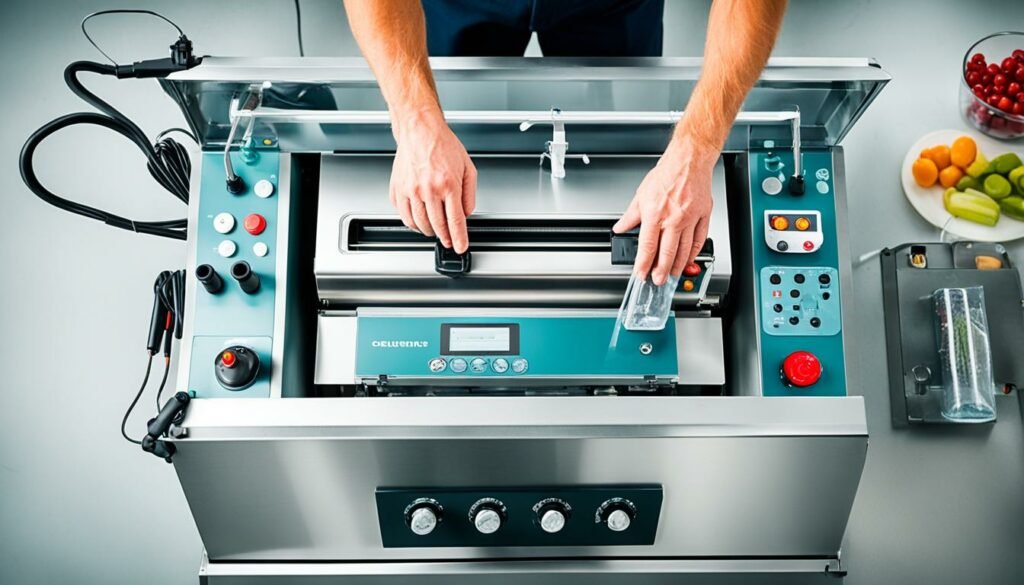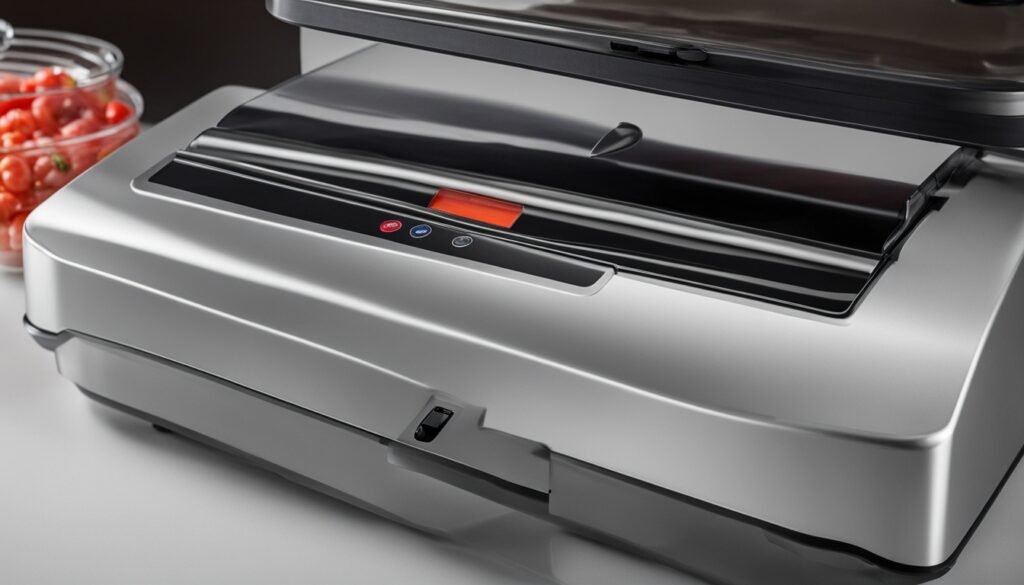Imagine you’ve made a big pot of chili for the family. But then, your vacuum sealer won’t work. It’s not just annoying; it could mean wasting food. We all get frustrated when kitchen gadgets like our vacuum sealers don’t cooperate because saving food matters. No matter your sealer’s brand, like Nutrichef or Anova, keep it working well for longer by using it right every time.
Improper use or storage often leads to problems. Not leaving enough space (2-3 inches) can make it hard to seal. A ½ inch in the hose is also needed. Little steps like this can stop the sealer from acting up. Make sure components like Teflon tape and heat bars are good too, as they’re not free to replace.
If your sealer stops working, try pressing the lid down for 3-4 seconds. Sometimes, it’s just a bad seal that’s the problem. But, problems like broken heat strips or clogged pumps are real issues too. Clean the sealer regularly to prevent these annoying issues. Nobody likes sealing a bag only to find air got in later.
Sometimes, the fix is in the details. Make sure the lid latches right to prevent air leaks. For tough issues, detailed guides are a great help. There’s lots of help in the troubleshooting section of the manufacturer’s site.

Common Causes of Vacuum Sealer Button Problems
Knowing about common vacuum sealer button problems is key to better machine care. Sticky residue and debris, along with wearing out, are major issues.
Sticky Residue and Debris
Often, sticky residue or debris causes button issues. Pickling brine and liquids can enter the device, clogging parts and causing buttons to stick. Cleaning the machine with warm water is a good first step. For more solutions, check out these vacuum sealing tips.
Worn Out Components
Buttons can also fail due to parts wearing out. Pieces like seal strips and gaskets might decay over time. It’s vital to do regular upkeep and change parts when needed. Fix vacuum sealer button issues promptly to avoid bigger problems.
Taking care of your appliances helps them last longer and work better. Simple steps, like folding the top of the bag or checking for defects, can prevent many problems.
If you find a bag that doesn’t work, contact the seller for a new one. Freezing food before sealing can stop juice leaks and keep bags neat, which makes sealing more effective.
Advanced user guides for appliances provide safety tips and help with common issues. For a deeper look, see this user guide.
Troubleshooting Vacuum Sealer Buttons that Won’t Respond
Are your vacuum sealer buttons not working? No need to panic. Just follow a few easy steps. We will look at how to check and clean to fix this issue.
Check for Electrical Issues
First, make sure your sealer is getting power. Look at the wiring and confirm it’s plugged in right. Sometimes, internal sensors or corrosion might be the cause. If you have a Vac750 Ultra, and the buttons still won’t work, contact the maker. They can give you more help. For detailed instructions, check out this guide on troubleshooting FoodSaver machines.
Inspect and Clean Buttons
Vacuum sealers can get sticky from spills or food bits. This makes the buttons not respond. Use a damp cloth to clean the buttons gently. Also, remember to clean your sealer’s buttons regularly. Doing this will help your machine last longer. For the best models, consider looking at lists of recommended vacuum sealers by experts like these best vacuum sealers.
- Check the power source and wiring for any obvious issues.
- Ensure the vacuum sealer is plugged in and the outlet functions properly.
- Clean the button area to remove any debris or sticky residue.
- If problems persist, consult the manufacturer’s instructions or reach out to customer service for further assistance.
Here’s a quick look at how three different models stack up when it comes to performance and usability:
| Model | Price | Weight | Power |
|---|---|---|---|
| FoodSaver FM2000 | $120 | 6.6 pounds | 120 watts |
| Anova Precision Vacuum Sealer Pro | $212 | 10 pounds | 127 watts |
| Geryon E2900-MS | $41 | 2.6 pounds | 110 watts |
Remember, taking good care of your vacuum sealer is crucial. This can make your food stay fresh much longer.
How to Fix Common Vacuum Sealer Button Problems
Fixing vacuum sealer button problems is often easy with some steps. Doing regular maintenance and changing parts can stop many issues. If you have problems, the first step is to make sure the buttons are clean. They should not have any sticky stuff on them. Clean them gently with a mild liquid to stop more issues.

Some problems might come from broken parts. A heat seal strip that doesn’t work well is often the problem. If this is the issue, buy and put in a new one. Also, don’t forget to check the vacuum pump for things blocking it. Clean it to avoid button problems.
Using the right grease is important too. A little silicone grease on the plastic parts inside can keep your sealer working well. Don’t fill bags too much. This can cause problems. Always follow the right bag filling rules.
Finally, keep an eye on your sealer. Do regular checks to spot and fix button problems early. Doing these maintenance steps often will make your sealer last longer and work better.
When to Seek Professional Help
If your vacuum sealer’s button won’t work, and trying to fix it yourself doesn’t help, it’s probably best to get a professional. These issues might be really technical. They could involve sensors or control boards. If you have an Anova model, they might help you fix it or find parts.
Older models or those with complex electrical problems need a pro’s touch. Even after trying to fix it, if the button still won’t work, you likely need help. Problems could be with the heating element (which happens in about 11% of cases) or a faulty gasket. Around 22% of users mention gasket issues.
Here’s when you should probably get help with your vacuum sealer’s button:
- Buttons keep breaking even after doing simple cleaning.
- If the sensor is acting up, only a pro should touch it.
- When the control panel stops working because of a circuit board issue.
With many users battling sealing problems, a pro check can pinpoint serious issues fast. This could be problems with wires, transformers, or switches. To really get to the bottom of these issues, check out this resource for detailed help.
Remember, sometimes fixing your vacuum sealer needs an expert’s eye. They’ll save you time and money, preventing more damage. Regular professional checks keep your sealer in top shape for longer.
For more tips or to try fixing it yourself, this guide is a good help. It walks you through checking bags and the heating system.
Conclusion
Dealing with a vacuum sealer’s buttons acting up can be really frustrating. But, knowing about the typical issues and how to fix them can help. Look out for sticky residues and check the parts that might be worn out. These solutions are often easy and can be done at home.
It’s key to check and clean the buttons regularly. Stop sticky stuff from building up. Also, make sure the electrical parts are in good shape. Doing this can keep your sealer working longer. Such steps save you both time and money on repairs.
Sometimes, you’ll need help from a pro. If you can’t fix the button problem on your own, they can help. Getting their advice early can prevent bigger issues. Remember, taking good care of your sealer and using it well can make it last longer. This makes your sealer a valuable tool for keeping food fresh.
FAQ
How do I fix button problems in my vacuum sealing machine?
First, clean any sticky residue from the buttons. It’s also important to replace old parts like heat seal strips and gaskets. Make sure to keep your machine clean and well-maintained. If problems continue, consider professional repair help.
What are common causes of vacuum sealer button problems?
Sticky residues, debris, and worn-out parts are often to blame. Things like pickling brine can lead to these sticky residues. Regular cleaning and maintenance will help prevent most problems.
How can I troubleshoot vacuum sealer buttons that won’t respond?
First, check the machine is getting power. Then, clean the buttons to remove dirt that might be stopping them from working. If that doesn’t work, check the internal sensors for any issues.
What steps can I take to fix common vacuum sealer button problems?
Begin by cleaning the machine and replacing any broken parts. If the heat seal strip is bad, get a new tape and install it. Also, make sure the pump is clean and greased to work smoothly. Remember to handle your bags properly too.
When should I seek professional help for my vacuum sealer button problems?
If you’ve tried common fixes and still have problems, or if it’s a complicated issue, contact an expert. Companies like Anova might assist you with parts for their models. For older models, like the Vac750 Ultra, getting professional advice or help is important.
How can I maintain my vacuum sealer to prevent button problems?
After every use, clean your sealer, especially if there was a spill. Make sure to replace any old parts and take care not to overstuff your bags. Store your machine correctly to avoid damage. Taking these steps will help keep your sealer in good condition.
